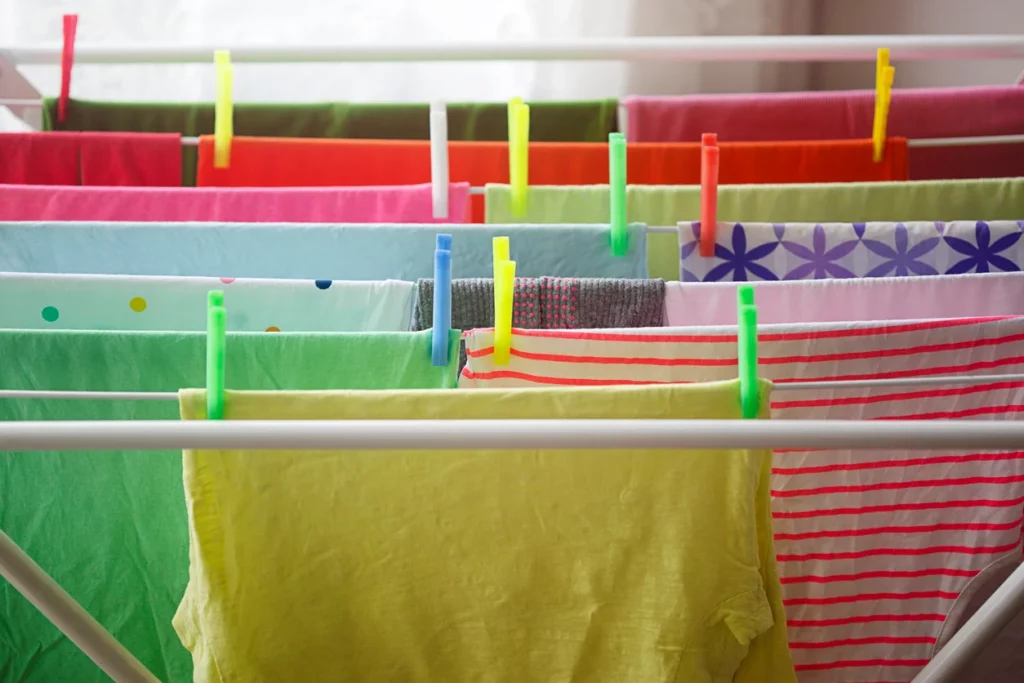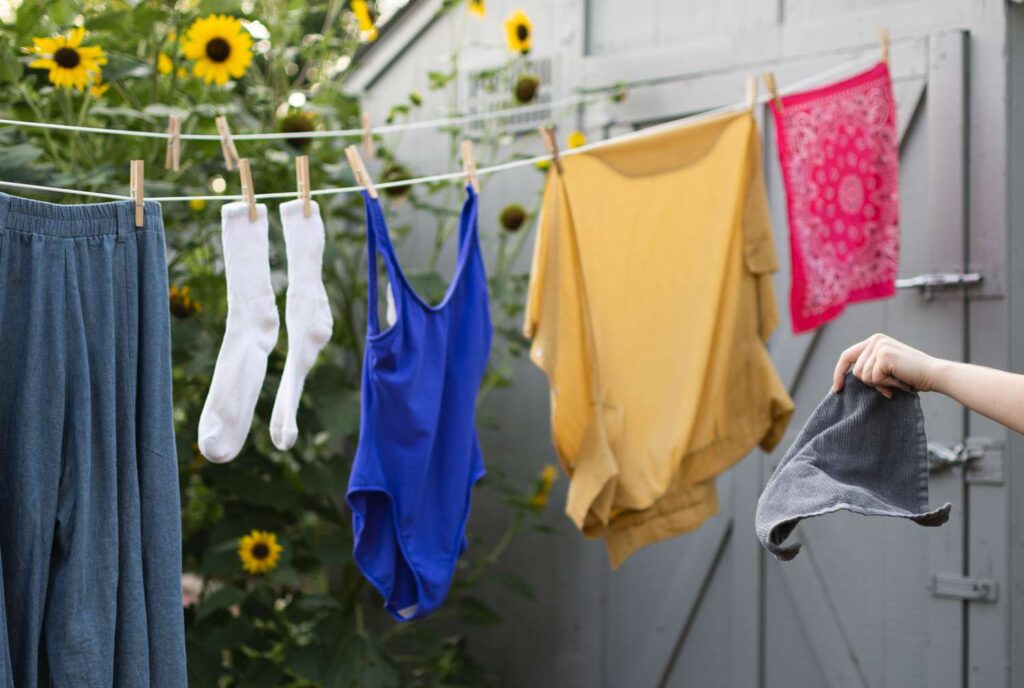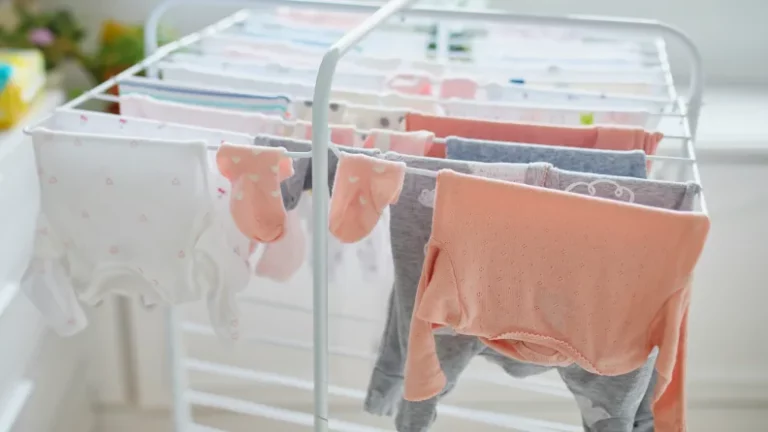Do you often find yourself pondering the question, “How long do clothes take to air dry?” It’s a common query that many of us have, whether we’re striving to save on energy costs, reduce our environmental footprint, or simply seek the convenience of air-drying our laundry.
Air-drying times can vary due to factors like fabric type, temperature, and wind, but generally, most fabrics will dry in 2 to 4 hours on a warm day with a light breeze.
Get ready to know more details.
Factors Affecting Air-Drying Time
Weather Conditions: The most significant factor is the weather. Clothes will dry much faster on a warm, sunny day with low humidity than on a cloudy, rainy, or humid day. Windy conditions can also speed up drying.
Fabric Type: Different fabrics dry at different rates. Lightweight and thin materials like cotton or linen usually dry faster than heavy and dense fabrics like denim or wool.
Clothing Thickness: Thicker and layered garments take longer to dry compared to single-layer items. For example, a thick sweater will take longer than a thin T-shirt.
Garment Size: Larger items, like bedding or a heavy winter coat, will take longer to dry compared to smaller items like socks or underwear.
Sunlight: Direct sunlight can help speed up the drying process, as it not only warms the clothes but also helps to kill bacteria and remove odors.
Air Circulation: Good air circulation is essential for effective drying. Hanging them on a clothesline or using a drying rack allows air to circulate around the garments, helping them dry faster.
Humidity Levels: High humidity can slow down the process, as the air is already saturated with moisture, reducing its capacity to absorb more.
Indoor vs. Outdoor Drying: Outdoor drying typically dries faster due to the combination of wind, sunlight, and better air circulation. Indoor drying can take longer because of limited ventilation and controlled temperature.
Initial Moisture Content: Clothes that are thoroughly wrung out or spun in a washing machine before air drying will dry faster than those dripping with excess water.
Elevation and Altitude: If you live at a high altitude, the lower air pressure can affect the boiling point of water, potentially leading to slower.
Choosing the Right Indoor Drying Rack

This guide will show you more details regarding this question.
1. Floor-standing Racks:
Pros:
- Portable and can be easily relocated to the room with the best conditions.
- Compact design, fitting into small and underutilized spaces.
- Affordability, allowing multiple units to make the most of available space.
- Foldable for convenient storage.
Cons:
- Prone to tipping, which can be caused by accidental bumps or outdoor breezes.
- Some inexpensive units may be fragile and difficult to repair.
- Layering of clothes on multiple rods can result in slower drying.
2. Wall-mounted Racks:
Pros:
- Convenient use of available wall space.
- Affordability, especially when multiple units are needed.
- Foldable design, easily tucked away when not in use.
Cons:
- Permanent installation requires secure wall fastening.
- Risk of overload and detachment from the wall with heavy loads or misuse.
- Finding a design that complements your decor can be a challenge.
3. Retractable Clotheslines:
Pros:
- Convenient use of overhead space that can be available at different times of the day.
- Affordability, with the option to use multiple single-line units for efficient use of space.
- Easy storage as the lines can be retracted and neatly stored.
Cons:
- Permanent installation, requiring secure wall mounting.
- Risk of overload and detachment with heavy loads or misuse.
- Cheaper brands may suffer from rope sagging and looseness.
- Aesthetic concerns, especially with large parallel line models.
4. Ceiling-mounted Racks:
Pros:
- Utilizes unused overhead space efficiently.
- Ensures efficient drying by avoiding layering of clothes and capturing warmer conditions.
- Convenient storage as it keeps the drying rack overhead and out of the way.
Cons:
- Permanent installation, requiring secure ceiling fastening.
- Risk of overload and detachment with heavy loads or misuse.
- Finding a design that complements your decor can be a challenge.
- Complexity in managing the cords used to lift the unit, which can be challenging for some.
Selecting the perfect indoor drying rack involves weighing these factors to match your specific needs, space, and style preferences. Ultimately, the right choice will ensure your laundry dries efficiently while seamlessly blending into your home environment.
How Long Do Clothes Take to Air Dry by Fabric Type?
| Type of Fabric | Indoor Drying Time | Outdoor Drying Time |
| Denim | Up to 24 hours | Up to 4 hours |
| Synthetics | Up to 5 hours | Up to 4 hours |
| Silk | Up to 45 minutes | Avoid Direct Sunlight |
| Cotton Clothes | Up to 8 hours | Up to 3 hours |
| Undergarments | Up to 2 hours | Around 30 minutes |
| Wool | 24 hours or more (turn inside out halfway through) | Avoid Direct Sunlight |
| Athletic/Moisture Wicking | Up to 2 hours | Around 30 minutes |
| Comforters | Up to 24 hours | Between 4-12 hours |
| Towels | Up to 24 hours | Between 3-6 hours |
Advantages of Drying Clothes Outdoors:
Energy Efficiency: Air drying your clothes outdoors is an eco-friendly choice that saves on energy costs. It can be expensive to run, and the energy-hungry heating element inside them can significantly contribute to your utility bills.
Savings: When you consider the cost of running a dryer, it becomes clear that is a money-saving option. Over time, the savings can add up, potentially offering you extra funds for other expenses or leisure activities.
Time and Effort Savings: Although it is convenient, it often leaves clothes wrinkled, requiring additional ironing. Air-dried clothes tend to be less wrinkled, reducing the time and effort needed for ironing. Additionally, you can mix lights and darks without worrying about color bleeding.
Fresh Smell: Sunlight and fresh air can naturally refresh your laundry, leaving your clothes with a pleasant, outdoor-fresh scent. Unlike clothes left in a dryer for hours, it doesn’t develop a musty or slightly burnt smell.
UV Disinfection: Sunlight’s UV rays have a disinfecting effect, effectively killing germs, bacteria, and viruses on your clothing. This natural disinfection is particularly beneficial for items that may harbor pathogens.
Disadvantages of Drying Clothes Outdoors:
UV Damage: Sunlight, while beneficial in some aspects, can also fade the colors of your clothing. To mitigate this effect, you can turn your clothes inside-out before hanging them on the line.
Birds and Mess: Unpredictable bird behavior can lead to unwanted surprises when drying clothes outdoors. Bird droppings can soil your laundry, necessitating re-washing, which can be inconvenient.
Rusted Clothes Pegs: Many traditional clothes pegs have metal springs that can rust when left on the line. Rusty pegs may stain your white clothes. To avoid this, consider using all plastic pegs, which are rust-resistant.
Maximizing Efficiency in Air-Drying Clothes: Tips for Speedy and Soft Results

Timely Hanging: Act swiftly after your laundry cycle to hang or lay out your clothes. Hastening this process minimizes wrinkles and aids in faster drying. Heavier items like wool can be placed on drying racks.
Enhance Airflow: Promote airflow within your drying area. Employ fans or ceiling fans to simulate a breeze, expediting the drying process. Adequate ventilation is crucial to thwart mildew and mold growth while reducing drying times.
Ventilation through Windows: Opt for a well-ventilated room to expedite the moisture evaporation from your clothes. This not only quickens drying but also mitigates the risk of mold, mildew, and unwanted odors.
Spacious Arrangement: Avoid overcrowding your drying area. Give your garments room to breathe by providing ample spacing. This allows for better drying and quicker results, particularly when drying clothes indoors.
If you opt for outdoor air-drying, consider these vital tips:
Monitor Humidity: The humidity in your outdoor environment significantly affects drying times. High humidity can prolong the drying process, even on sunny days.
Patience in Cold Weather: Cold weather can extend drying times, but it’s still feasible. Choose sunny days with a natural breeze in cold climates for optimal results.
Strategic Placement: Different fabrics require varying levels of care when it comes to sunlight exposure. While items like jeans benefit from direct sunlight, delicate fabrics such as silk and wool should be shielded from harsh sunlight to prevent fading and damage.
Spacing Matters: Outdoors or indoors, ensure that clothes have ample space between them. Overlapping or closely packed garments can hinder the drying process.
To expedite drying when time is of the essence, consider these additional tips:
Prioritize High-Need Items: Give priority to items that require quick drying. Allocate them more space and prime locations. Be cautious not to let non-prioritized clothes attract mildew.
Wash in Smaller Batches: Plan your washing batches strategically. Smaller loads create more space and better air circulation for faster.
Dehumidifier (Indoor Drying): In indoor drying a dehumidifier can be a valuable tool to reduce humidity levels, accelerating the drying process. Consider using a dehumidifier like this one from Amazon.
FAQs
Are Air-Drying Clothes Effective?
Yes, Air-drying your clothing beats sticking it in the dryer. Your clothing lasts longer, dries faster, and experiences less wear and tear. However, remember to turn your garments inside out to stop the sun from fading the colored fabrics.
Does Clothing Dry Faster Indoors or Outdoors?
Leaving your clothing outdoors in the sun will dry your clothes four to five times faster than indoors. However, if it’s overcast or raining outdoors, you might have no choice but to bring the clothesline indoors. Of course, running the clothes through a dryer will be faster than either of the previous options.
Will My Clothes Dry Outdoors in the Cold Air During Winter?
Yes. Your clothes will dry outdoors in the winter. However, if the temperatures are below 50 °F, they might take the whole day to dry, and you might even need a second day to dry them. In that case, it’s better to dry them indoors.
Will My Clothes Dry if I Leave Them on the Washing Line at Night?
Yes. You can leave your laundry out on the line to dry overnight. However, it depends on the weather conditions in your area. Some regions might experience dew overnight that wets your clothes, or it might rain unexpectedly. It might also become increasingly cold in the small hours of the night.
Why Do Clothes Take Longer to Dry Near the Coastline?
If you live in a beach house, the humidity coming off the ocean in the summertime will increase the dew point in the air, slowing the drying time of your clothing.
Why should I consider air-drying my clothes instead of using a dryer?
Air-drying your clothes saves you money on energy costs, reduces your carbon footprint, helps your clothes last longer, and offers the freshness of naturally dried laundry.
How much can I save on energy costs by air-drying my clothes?
On average, electric dryers account for around 6 percent of your home’s annual energy consumption. By air-drying your laundry, you can significantly reduce this cost.
Does air-drying clothing have any impact on the fit of my clothes?
Yes, air-drying is gentler on fabrics like cotton, wool, rayon, and linen, reducing the risk of shrinking. Dryers, on the other hand, can cause fabric fibers to pull together tightly, leading to a change in clothing size.
Are there any practical tips for air-drying clothes effectively?
Yes, Make sure to keep your clothesline clean, avoid hanging laundry outdoors on high-pollen days, hang the largest items first to maximize space, and give clothes a good shake before air-drying to prevent stiffness.
What should I do when air-drying heavy garments like sweaters?
Instead of hanging knit sweaters, lay them on a flat rack to prevent sagging. Turn them over once or twice during drying for even results.
What precautions should I take when air-drying bright and dark fabrics?
Avoid direct sunlight for dark or bright garments to prevent fading. Opt for a shaded but warm spot with a gentle breeze.
Can I air-dry down garments or bedding?
No, It’s best to dry down comforters, jackets, and pillows in the dryer with some tennis balls to maintain their fluffiness. Air-drying may lead to clumping.
Is it important to fold laundry immediately after air-drying?
Yes, folding clothes as you remove them from the line or rack prevents wrinkles and keeps your laundry crisp and clean.
How long does it take for clothes to air-dry when hung outside?
The drying time varies based on fabric type, air temperature, and wind. On a warm day with a light breeze, expect it to take 2 to 4 hours for most types of fabric.
What type of hangers should I use for air-drying delicate items?
Thin plastic hangers are the best choice for delicate items because they are less likely to warp clothing. Avoid velvet, wooden, or metal hangers.
Is there a trick to speed up the air-drying process for towels?
Yes, you can blot excess moisture from wet towels using a dry towel before hanging them on the line. This can help reduce drying time.
Final Words
The time it takes for clothes to air dry can vary significantly depending on several factors. The fabric type, air temperature, wind, and humidity levels all contribute to the drying time.
On a pleasantly warm day with a light breeze, most fabrics can dry within 2 to 4 hours. However, it’s important to note that these are approximate estimates, and the actual drying time may differ in individual cases.
Moreover, to ensure the best results, it’s advisable to consider these factors and monitor the drying process carefully. Ultimately, air drying your clothes can save energy, reduce your carbon footprint, and extend the lifespan of your garments, making it a sustainable and cost-effective laundry option.

